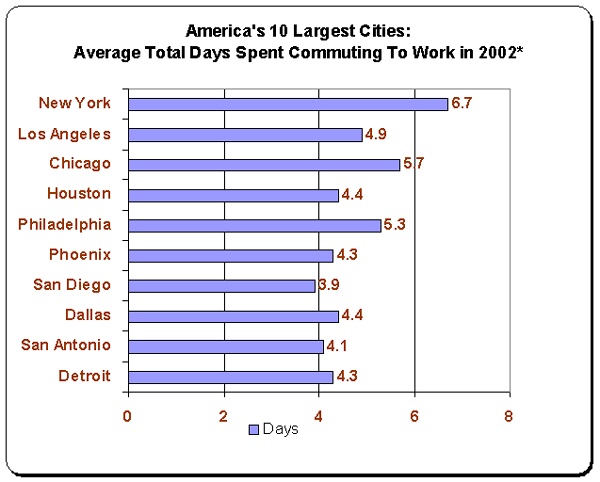
FOR IMMEDIATE RELEASE |
|||
| Stephen Buckner | CB04-CN.01 | ||
| Public Information Office | |||
| (301) 763-3691/457-3620 (fax) | Detailed tables: | ||
| (301) 457-1037 (TDD) | States | ||
| e-mail: pio@census.gov | Counties | ||
| Cities | |||
| Commuter Blues | |||
New York Has Longest Commute to Work in Nation, |
|||
New York City residents spend an average of about one full week a year getting to work — the longest commute time in the nation among large cities, according to a new ranking of American Community Survey data released today by the U.S. Census Bureau. New York City residents take an average of 38.4 minutes to get to work each day — more than five minutes longer than Chicagoans, who face a commute of 32.7 minutes. Other large cities with populations of 250,000 or more with long commutes include Philadelphia (30.3 minutes), Riverside, Calif. (29.8), Baltimore (29.7), Washington, D.C. (29.4), San Francisco (29.2), Oakland, Calif. (29.1), Los Angeles (28.5) and Boston (28.2). (See Table 1.) “Planners and policy-makers have told us that they need these data to develop a local transportation infrastructure,” said Census Bureau Director Louis Kincannon. “Commuting trends are critical as a city decides whether to increase its public transportation or build new roads.” Of the 231 counties ranked in the American Community Survey, four of New York City’s five boroughs — Bronx (41.8 minutes), Queens (41.4), Richmond (Staten Island) (41.2) and Kings (Brooklyn) (39.9) — have the longest commute times by far. Other counties in the New York metropolitan area with long average commute times include: Nassau in New York (34.1) and Monmouth in New Jersey (32.4). Additionally, three counties neighboring Washington, D.C., also face long commutes: Prince William, Va. (35.5); and Prince George’s (34.6) and Montgomery, Md. (30.9). (See Table 2.) States with some of the longest commute times are New York (30.8 minutes), Maryland (30.0), New Jersey (28.3), Illinois (26.7) and California (26.6) — all above the national average of 24.4 minutes. States with the shortest commute times are North Dakota (14.8 minutes), South Dakota (15.0), Nebraska (16.1) and Montana (16.7). Other survey highlights: • Approximately two-thirds of states have shorter commute-to-work times than the national average of 24.4 minutes. • Lancaster County, Neb.
(15.8 minutes), Erie County, Pa. (16.5), and Polk County, Iowa (16.9),
have some of the shortest
commutes among counties surveyed. The American Community Survey annually provides communities with socio-economic data previously available every 10 years. The survey will be conducted monthly in every county in the country beginning in July 2004, eliminating the need for the census long form in 2010. The findings are based on
responses from a sample of households interviewed in 2002. As with all
surveys, the estimates and rankings may vary from the actual values because
of sampling or nonsampling variations. The above statements have undergone
statistical testing, and comparisons are significant at the 90 percent
confidence level.
|
|||
| -X- |
|||

